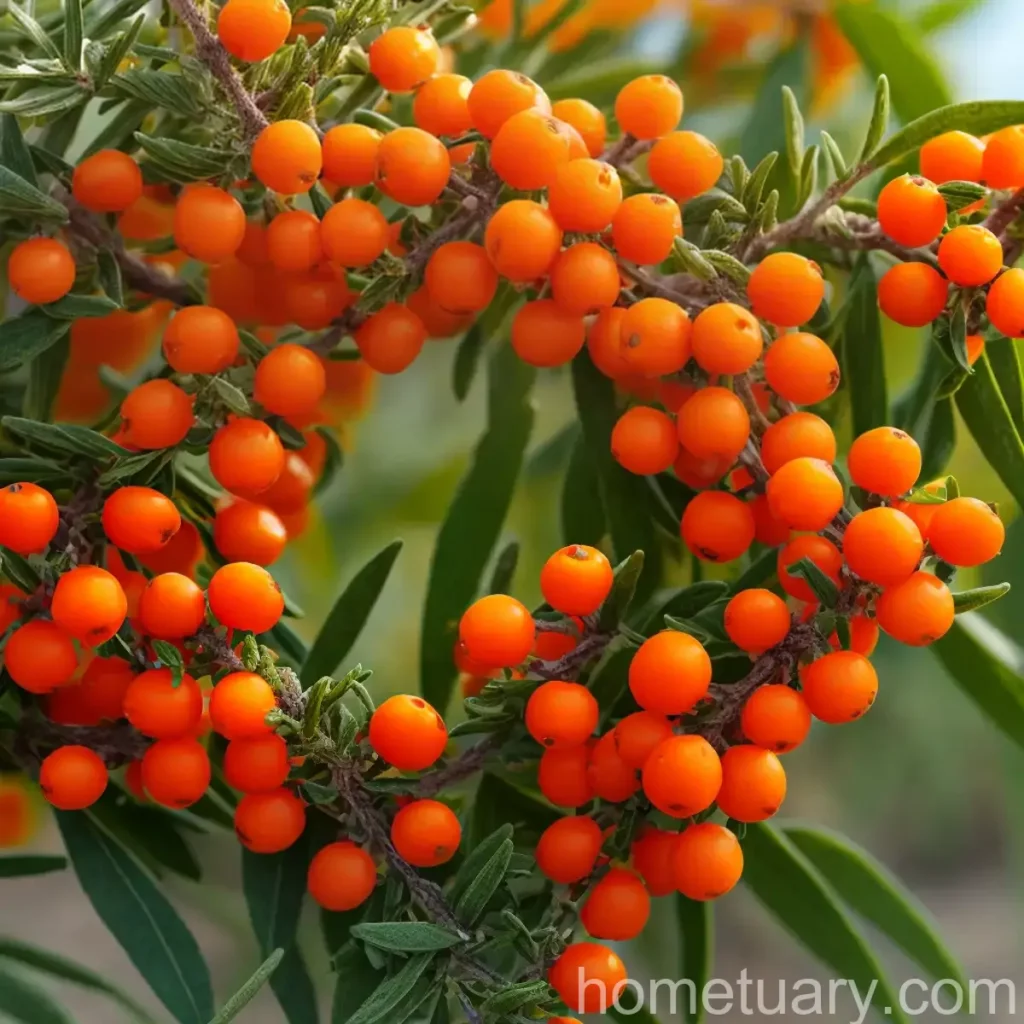Sea Buckthorn (Hippophae rhamnoides): A Comprehensive Guide
Sea buckthorn (Hippophae rhamnoides) is a versatile and resilient plant that has been used for centuries due to its exceptional nutritional and medicinal properties. This blog post aims to provide a comprehensive guide to sea buckthorn, covering its culture, uses, care requirements, common diseases, pests, propagation, and more. Whether you are a seasoned horticulturist, a farmer looking to diversify crops, or a gardening enthusiast interested in exploring new plant varieties, this guide will equip you with the knowledge to successfully cultivate and care for sea buckthorn.

Image source: Dictionary.com
What is Sea Buckthorn (Hippophae rhamnoides)?
Sea buckthorn, scientifically known as Hippophae rhamnoides, is a deciduous shrub belonging to the Elaeagnaceae family. It is native to the cold-temperate regions of Europe and Asia, including the Himalayas, and is particularly well-suited to harsh growing conditions such as poor soil, drought, and extreme temperatures. The plant is valued for its vibrant orange berries, which are rich in essential nutrients, including vitamins, minerals, and bioactive compounds. These attributes have led to the widespread utilization of sea buckthorn in traditional medicine, skincare products, culinary preparations, and agroforestry systems.
Key Takeaways
Sea Buckthorn (Hippophae rhamnoides)
- Botanical Name: Hippophae rhamnoides
- Common Names: Sea buckthorn, sandthorn, sallowthorn
- Family: Elaeagnaceae
- Native Habitat: Europe and Asia
Culture
Uses
Sea buckthorn offers a myriad of uses, encompassing various sectors such as healthcare, nutrition, agriculture, and cosmetology. The following are some key uses associated with sea buckthorn:
- Sea buckthorn health benefits
- Sea buckthorn uses in traditional medicine
- Sea buckthorn culinary applications
- Sea buckthorn in agroforestry and landscaping
- Sea buckthorn skincare and cosmetic products
Water
Sea buckthorn is an adaptable plant with moderate water needs. While it can withstand drought conditions once established, adequate irrigation is essential, especially during its initial growth phase and periods of extreme dryness.
Sunlight
This plant thrives in full sun exposure and exhibits optimal growth and berry production when provided with ample sunlight.
Fertilizer
Sea buckthorn is capable of thriving in poor soils, thanks to its nitrogen-fixing abilities and capacity to access nutrients from challenging environments. While minimal fertilization may be needed, nitrogen supplementation can be beneficial in nutrient-deprived soil conditions.
Soil
The plant is well-suited to a wide range of soil types, including sandy, loamy, and even infertile soils. It prefers well-drained soil and tolerates a broad pH spectrum, ranging from acidic to alkaline.
Pruning
Pruning can promote a more structured growth pattern, enhance berry production, and ensure the longevity of the plant. Regular pruning of dead or overgrown branches is advisable, especially during the dormant season.
Propagation
Sea buckthorn can be propagated through various methods, such as seeds, cuttings, and layering. Each technique offers unique advantages and challenges, allowing for flexibility in propagation approaches based on specific requirements and environmental conditions.
Container Popularity
Due to its adaptability and ornamental value, sea buckthorn is increasingly sought after for container gardening, enabling individuals with limited garden space to still benefit from its valuable attributes.
Common Diseases
Sea buckthorn is generally resistant to many pathogens, but it may still be susceptible to certain diseases under unfavorable conditions. Some common diseases that can affect sea buckthorn include:
- Rust diseases (e.g., Gymnosporangium spp.)
- Powdery mildew (Erysiphales)
- Leaf spot diseases (e.g., Septoria spp.)
Disease Diagnosis
Proper diagnosis of diseases affecting sea buckthorn is crucial for implementing effective control measures. Symptoms such as leaf discoloration, spots, or abnormal growth patterns should be carefully examined to identify the underlying cause and initiate appropriate management strategies.
Common Pests
Despite its resilience, sea buckthorn may face challenges from various pests, including aphids, spider mites, and fruit flies. Regular monitoring and prompt intervention are essential for mitigating pest infestations and safeguarding plant health.
Botanist’s Tips
Sea buckthorn is a remarkably versatile plant that offers numerous benefits. Here are some key tips to maximize the potential of sea buckthorn cultivation:
- Site Selection: Choose a sunny, well-drained location for planting sea buckthorn to optimize its growth and berry production.
- Watering: Provide consistent moisture, especially during the establishment phase, to support vigorous root development.
- Pruning: Regularly prune sea buckthorn to maintain plant health, improve air circulation, and stimulate fruit production.
- Nutrient Management: While sea buckthorn is tolerant of poor soils, providing adequate nutrients can enhance its performance and yield.
Fun Facts
- Sea buckthorn berries are exceptionally rich in vitamin C, containing higher levels of this essential nutrient than oranges.
- The plant’s orange berries are traditionally used to produce jams, juices, and liquors with a distinct tangy flavor and vibrant color.
- Sea buckthorn demonstrates excellent potential for soil stabilization and erosion control, making it a valuable asset in ecological restoration projects.
Links to External Resources
For further information on sea buckthorn and related topics, you may find the following external resources helpful:
In this comprehensive guide, we’ve delved into the multifaceted world of sea buckthorn (Hippophae rhamnoides), exploring its cultural significance, diverse uses, care requirements, common diseases and pests, and insightful tips for successful cultivation. Whether you’re intrigued by its nutritional properties, medicinal applications, or horticultural potential, sea buckthorn stands as a remarkable botanical treasure with a wealth of offerings.
Through the integration of sea buckthorn into diverse domains such as healthcare, agriculture, and environmental conservation, we can harness the full spectrum of benefits this resilient plant has to offer. In the pursuit of sustainable agriculture, agroforestry, and holistic well-being, sea buckthorn emerges as a valuable ally, enriching our lives and landscapes with its valuable attributes.
As we continue to uncover the untapped potential of plant species like sea buckthorn, we embark on a journey toward a more harmonious relationship with nature, where the bounty of botanical treasures enriches our lives and fosters a deeper connection with the natural world.















